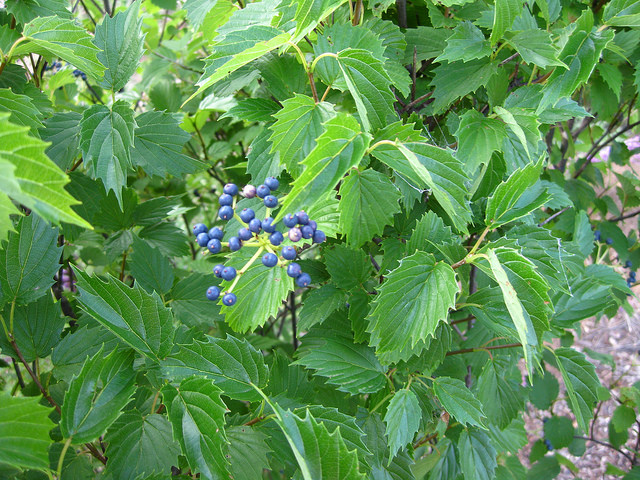Resource Library
Plant of the Week: Viburnum dentatum, Arrowwood Viburnum
FAYETTEVILLE, Ark. -- Names are important because in a single word or phrase they provide a lot of useful information. Arrowwood viburnum (Viburnum dentatum) is a good example of the impact of naming. On first hearing the name, even the plant-illiterate conjure up images of long, straight suckers to use in building arrow shafts. If we know a few plants we recognize that the plant is a large, white flowered shrub with notched leaves. Just like naming a puppy, sometimes it just seems to fit like a glove.
Viburnums are a large group of 175 mostly deciduous flowering shrubs native across the northern hemisphere, with many native across North America. Because of genomic research Viburnums, long considered a part of the honeysuckle family, are now combined in the Adoxaceae family. Arrowwood viburnum is native from Maine to Iowa, South to east Texas and into Georgia. It is common in wild places in Arkansas.
The shrub grows 8 to 10 feet tall and wide and forms a rounded, multi-stemmed mass of gray-black branches. Once established shrubs will sucker from the roots near the base of the plant, producing straight, slender stems ideally suited for arrow shafts.

Arrowwood Viburnum. Planot of the Week, July 13-20.
Leaves are opposite on the branches, 2 to 4 inches long, oblong in outline with coarsely serrate (dentate) margins. Several closely allied species have been described with similar leaves but V. dentatum is the native to garner most attention in the nursery trade. Leaves appear early and are bright, shiny green and take on fall color hues ranging from yellow to orange or red. Many of the over two-dozen named selections of arrowwood viburnum were selected for their fall foliage display.
Arrowwood viburnum flowers are individually tiny but massed in a creamy white flat-topped cluster 3 to 5 inches across and appear in the first half of May in north Arkansas. The flowers have an off-putting fragrance if sniffed up close. Fruit appear in late summer and are single seeded, to a quarter inch long and blue to blue-black in color. ‘Blue Muffin’ was selected for its striking blue fruit.
Birds relish the fruit when ripe. Viburnums usually have a two-year dormancy for seed germination so reseeding has been relatively slow around the plants I have observed but it does occur.
Native peoples did use suckers of viburnum for making arrow shafts but it was only one of many choices available to them. The Otzi Iceman, the 5,300-year old hunter found in a glacier in the Austrian Alps in 1991, had a quiver of 14 arrows. Twelve of these were unfinished shafts comprised of viburnum wood and dogwood. In the Americas arrowwood viburnum was used by the Iroquois but shrubby dogwood species were also favored because the wood dried hard and straight. Other tribes used other material including river cane, ash, hickory and witchhazel.
Arrowwood viburnum is a big, tough shrub that is suited for use in supporting roles in the garden. It is excellent for hedging, screening, massing or use in the mixed border but is not refined enough to use as a specimen plant. It tolerates acidic or alkaline soils, is drought tolerant once established and not ravaged by insect or disease. Plants are hardy from zone 3 through 8. It tolerates shearing well and size can be controlled with periodic pruning after the plants have bloomed.
For more information about horticulture, or to see other Plant of the Week columns, visit extension’s website Arkansas Yard and Garden Resources or contact your county extension agent.
Pursuant to 7 CFR § 15.3, the University of Arkansas System Division of Agriculture offers all its Extension and Research programs and services (including employment) without regard to race, color, sex, national origin, religion, age, disability, marital or veteran status, genetic information, sexual preference, pregnancy or any other legally protected status, and is an equal opportunity institution.